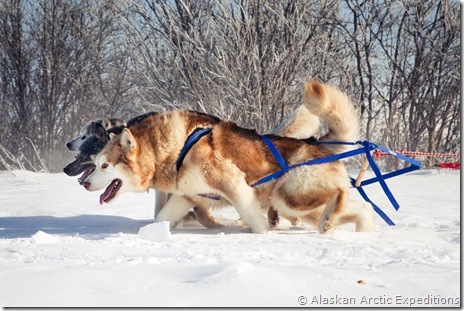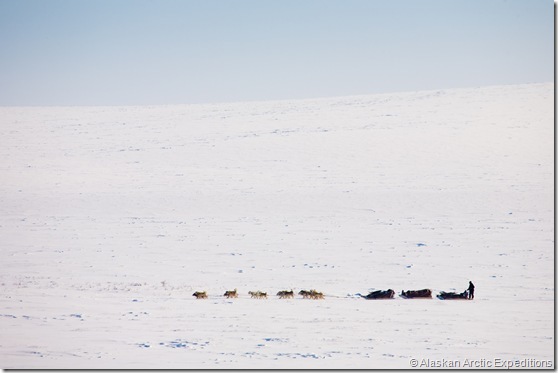June 10, 2012
My Old-Time Huskies
In his youth, Bear was a master Arctic navigator who guided us through blistering blizzards with his eyes closed. He navigated using the wind direction and the snow drifts lying across the sea ice like a compass. He could detect thin ice by scent and feel our old trail under a foot of fresh snow. If he were human he’d be legendary and stories of his Arctic mastery would be passed down for generations. But he’s not human, and to me he is more than legendary. He’s been a loyal friend and traveling companion for over a decade. But let’s go back to the beginning, before Bear was born, and before his father and grandfathers were born. Back in the days when man and dog lived together harmoniously, depending on one another for survival, companionship and comradery.
Bear on the right, Boss in the middle, and Farmer, Photo taken by Angus Mill

Along Alaska’s northern coast and deep in the Brooks Range lived a robust, hardy people, the Inupiat, meaning the real people, and with the Inupiat lived an equally hardy dog called the Alaskan malamute. This powerful dog breed was the backbone of dog teams on Alaska’s coastal region from Kotzebue to Barter Island and into Canada. They were enduring brutes with uncanny intelligence, heavy bones, large paws and thick coats that were impenetrable in blizzards. They were true survivors in an outright brutal environment, yet they were loving and personable dogs.
Bear leading the team across the Arctic tundra and teaching Farmer the ropes. Photo taken By Angus Mill

For centuries, both Inupiat and malamute existed together. Without the Inupiat caring for their malamute companions, this majestic dog would never have survived, and without the malamutes assisting the Inupiat in hunting and pulling sledges, the Inupiat certainly would have suffered greatly. Man and beast relied on each other for survival.
But changes came for the malamute during the 1900 gold rush when a tidal wave of humanity hit the sandy beaches of the northern Alaska coast in what is now known as the town of Nome.
Buried in the sand and in surrounding creeks and rivers were rich pockets of gold, but this yielded only to the lucky few. Nonetheless, news of gold miners becoming rich beyond their wildest dreams spread like wildfire, and soon men and women traveled from around the globe to secure their fortune.
Approximately 20,000 gold seekers had taken residence on the beach of Nome during the period of 1900 to1909, and the area became one of the largest tent cities in Alaska. In the midst of this chaotic turmoil of adventurers and gold seekers shoveling and sifting through the sand were the Alaskan malamutes humbly minding their own business. Just the very look of the malamutes was enough to catch the attention of nearly every weathered, worn, cold, gold miner in the territory. The miners had never seen such handsomely powerful dogs before. And right away, most of the malamutes were purchased from the Inupiat in the direct vicinity, harnessed, and put to work pulling sledges and packing supplies on their backs. But there weren’t enough malamutes in the country to satisfy the needs of every gold miner wandering into the country, so dogs were shipped to Nome from the lower 48 states to satisfy the demand. However, most of the dogs that arrived were insufficiently furred, spoiled, and soft-minded, and swiftly died from exposure during the winter blizzards that swept the beaches and surrounding hills. But Mother Nature spared a few of the strongest dogs and these lucky creatures were introduced to the local Alaskan malamutes. And that’s when a new dog breed was born—the Alaskan husky.
Here’s Bear settling in for the night after a long day of breaking trail. Photo by Angus Mill

Eventually the Alaskan husky evolved into a very tough dog, but unlike the malamute, they didn’t have the large bones, head, and paws. They were a lighter and swifter runner though, and as dogsled racing increased popularity they became highly valued.
Bear on the left, enjoying himself during the 2012 expedition.

Over the past 100 years, the Alaskan husky has evolved into one of the fastest long distance racing sled dogs, but because of several different bloodlines introduced into them, like the German short haired pointer, they are unrecognizable to the muscular and thick furred old-time Alaskan husky of the early1900’s, although there are some Alaskan huskies that haven’t changed. Their bloodlines have been preserved, but they are few and far between. And this is where Bear comes in…these are his roots.
Farewell for now!! Bear on the left, his granddaughter next to him, and Boss and Farmer on the right.

As long as I’ve had sled dogs, I’ve preserved this old-school husky bloodline, keeping a couple of them in my kennel and in the team alongside my purebred malamutes. Bear, has been one of my main leaders for over a decade and he is from the old Alaskan Husky bloodline. Now 12 years old, Bear is approaching retirement, and I wanted to commemorate this post to him and all the old-time Alaskan huskies out there doing what they were born to do.
- Barbara
Your dedication to these dogs is inspiring. Breeding, care, fulfillment of their working desires: all of these things come together in some of the happiest, strongest most beautiful dogs I have ever seen.
- Barbara
And I forgot to say that Bear looks rugged enough, strong enough, and tough enough to handle just about anything the Arctic could throw at him. Love his face.
- Carolyn Schlick
Bear is one of the most recognizable on the team, and one of the easiest to remember, after learning all those names on my trip! I’m happy he’s been hanging in there all these years.
- Mare Wood
A well deserved retirement, although next expedition, I am sure he will be voicing his opinion!

